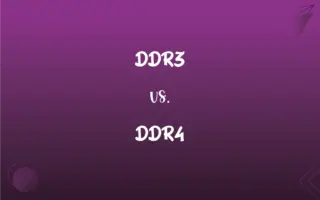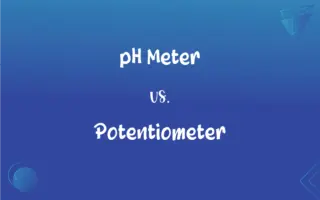FCC vs. HCP: What's the Difference?
By Aimie Carlson & Janet White || Published on October 9, 2024
FCC has atoms at each corner and the centers of all the cube faces, leading to a highly dense packing. HCP has atoms at each corner and the center of each hexagonal face with a different stacking order also resulting in high density.

Key Differences
FCC and HCP structures represent different ways in which atoms are arranged in a crystalline solid, influencing the material's properties such as density, ductility, and slip systems.
In an FCC structure, atoms are arranged at the corners and the centers of all the faces of a cube. This arrangement allows for atoms to be closely packed, with each atom touching twelve others. HCP, on the other hand, consists of atoms at the corners and the centers of only the top and bottom faces of a hexagon, with a repeating ABAB pattern. Each atom in an HCP structure touches twelve others, similar to FCC, but the arrangement leads to different physical properties.
HCP metals, such as magnesium, titanium, and zinc, often have limited slip systems compared to FCC, which can make them less ductile and harder to work with at room temperature.
Both structures achieve close packing and high density, but the symmetry and stacking differences lead to varied mechanical and physical properties in materials with these lattice types. The choice between FCC and HCP structures in materials science depends on the required properties of the final product, such as strength, ductility, and resistance to corrosion.
Comparison Chart
Atom Locations
Corners and centers of all cube faces
Corners and centers of hexagonal faces
ADVERTISEMENT
Coordination Number
12 (each atom touches 12 others)
12 (each atom touches 12 others)
Packing Efficiency
74% (same as HCP)
74% (same as FCC)
Slip Systems
Multiple, making it more ductile
Fewer, often leading to reduced ductility
Common Materials
Aluminum, copper, silver
Magnesium, titanium, zinc
Symmetry
Cubic
Hexagonal
ADVERTISEMENT
Deformation Behavior
Easier to deform due to more available slip systems
Harder to deform at room temperature
Applications
Extensively used in materials requiring deformation
Often used in high-strength applications at low weights
FCC and HCP Definitions
FCC
Features atoms at cube corners and face centers.
Copper's high electrical conductivity is attributed to its FCC lattice.
HCP
Suitable for high-strength, low-weight applications.
HCP cobalt is used in superalloys for aerospace.
FCC
Allows easy deformation, making materials ductile.
Silver's FCC structure makes it ideal for jewelry making.
HCP
A structure with atoms in a hexagonal pattern.
Titanium's strength-to-weight ratio benefits from its HCP structure.
FCC
A crystal structure with high packing density.
Aluminum's malleability is due to its FCC structure.
HCP
Characterized by ABAB stacking order.
Zinc's corrosion resistance is partly due to its HCP lattice.
FCC
Found in metals that require extensive deformation.
FCC structure in gold allows for thin gold leaf production.
HCP
Limited slip systems affect ductility.
The HCP structure in magnesium makes it less malleable.
FCC
Exhibits cubic symmetry with multiple slip systems.
Nickel's FCC arrangement contributes to its toughness.
HCP
Exhibits hexagonal symmetry with fewer slip planes.
The HCP arrangement in beryllium is critical for nuclear applications.
FCC
(crystallography) face-centered cubic
HCP
Initialism of hexagonal close-packed
FCC
An independent governmeent agency that regulates interstate and international communications by radio and television and wire and cable and satellite
FAQs
How does the packing efficiency impact material properties?
The packing efficiency, which is similar in both FCC and HCP structures, affects the density and mechanical properties of the material, with higher packing efficiency generally leading to higher density and strength.
Can a metal transition between FCC and HCP structures?
Yes, some metals can undergo phase transitions under specific conditions, such as temperature or pressure changes, altering between FCC and HCP structures.
What determines whether a metal has an FCC or HCP structure?
The energy stability associated with electron configurations and atomic sizes influences whether a metal adopts an FCC or HCP structure.
What role does temperature play in the stability of FCC and HCP structures?
Temperature can affect the stability and transition between FCC and HCP structures, with some metals transitioning to one structure or another at specific temperatures due to changes in atomic mobility and bonding.
Why are FCC metals generally more ductile than HCP metals?
FCC metals have more slip systems available, allowing them to deform more easily under stress without fracturing, contributing to greater ductility.
How do FCC and HCP structures affect the electrical properties of materials?
The crystal structure influences electrical conductivity, with FCC metals typically exhibiting higher conductivity due to their dense packing and uniform structure facilitating electron flow.
Which materials commonly exhibit the FCC structure?
Materials with FCC structure include metals like aluminum, copper, gold, and silver, known for their ductility and high electrical conductivity.
Are there materials that do not fit into either FCC or HCP structures?
Yes, many materials crystallize in different structures, such as body-centered cubic (BCC) or more complex lattice arrangements, depending on their atomic configurations and bonding characteristics.
How does the choice between FCC and HCP structures affect material selection in engineering?
Engineers select materials based on required properties like strength, ductility, and corrosion resistance, with the crystal structure (FCC or HCP) being a key factor influencing these characteristics.
Why are HCP structures less common in industrial applications than FCC structures?
HCP structures are less common in applications requiring extensive deformation due to their limited slip systems, making them harder to work with than the more ductile FCC-structured metals.
What are examples of materials with an HCP structure?
Metals such as magnesium, titanium, and zinc typically have an HCP structure, which contributes to their high strength-to-weight ratio but limited ductility compared to FCC metals.
Can alloys have FCC or HCP structures?
Yes, alloys can adopt FCC or HCP structures, and the presence of alloying elements can stabilize one structure over the other, enhancing desired material properties.
How do FCC and HCP structures affect material properties?
FCC structures contribute to greater ductility and isotropy, making materials easier to form and shape, while HCP structures offer directional strength but can be more brittle and harder to work due to limited slip systems.
Can a material transition between FCC and HCP structures?
Yes, some materials can undergo allotropic transformations under certain conditions, changing between FCC and HCP structures, which significantly affects their mechanical properties. An example is cobalt, which transitions from HCP to FCC at higher temperatures.
What role does the crystal structure play in determining a material's hardness?
The crystal structure, by dictating how atoms are arranged and how they can move past each other, influences a material's hardness. Generally, materials with HCP structures tend to be harder than those with FCC structures due to more restricted slip systems.
What distinguishes FCC and HCP crystal structures?
FCC (Face-Centered Cubic) has atoms at each corner and the centers of all the cube faces, offering high packing density and isotropy, while HCP (Hexagonal Close-Packed) consists of atoms at the corners and center of hexagonal faces, plus an additional atom at the middle of the hexagon, leading to anisotropic properties due to its layered structure.
Why is the FCC structure preferred for some applications?
The FCC structure is preferred for applications requiring good formability and resistance to corrosion, making FCC metals ideal for electrical wiring, decorative applications, and in components requiring extensive deformation.
How do FCC and HCP structures impact welding and machining processes?
FCC metals are generally easier to weld and machine due to their greater ductility and ability to deform without fracturing, whereas HCP metals might require more careful handling to avoid cracking due to their more limited slip planes.
How does the packing efficiency compare between FCC and HCP structures?
Both FCC and HCP structures have high packing efficiencies of approximately 74%, but their different arrangements lead to unique physical and mechanical properties.
Can FCC and HCP structures be found in non-metallic materials?
While FCC and HCP structures are most commonly associated with metals, certain non-metallic materials, like some polymers and ceramics under specific conditions, can exhibit similar close-packed arrangements.
About Author
Written by
Aimie CarlsonAimie Carlson, holding a master's degree in English literature, is a fervent English language enthusiast. She lends her writing talents to Difference Wiki, a prominent website that specializes in comparisons, offering readers insightful analyses that both captivate and inform.
Co-written by
Janet WhiteJanet White has been an esteemed writer and blogger for Difference Wiki. Holding a Master's degree in Science and Medical Journalism from the prestigious Boston University, she has consistently demonstrated her expertise and passion for her field. When she's not immersed in her work, Janet relishes her time exercising, delving into a good book, and cherishing moments with friends and family.






































































